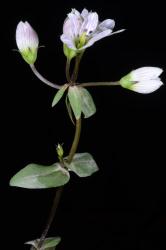- Taxon
- Gallery
- ≡ Gentiana tenuifolia Petrie, Trans. & Proc. New Zealand Inst. 45: 270 (1912 [1913])
- ≡ Chionogentias tenuifolia (Petrie) L.G.Adams, Austral. Syst. Bot. 8: 978 (1995)
Plants monocarpic, biennial, height in flower 230–530 mm. Caudex unbranched, 7–65 mm long. Root 2.1–7.0 mm diam. at stem base. Flowering stems terminal only or terminal and lateral, 1–8 per plant, largest flowering stem 1.6–3.9 mm diam. at base, central flowering stem more robust than the laterals, stem colour green or tinted crimson, lateral flowering stems erect or decumbent, flowering stem leaves 4–6 pairs per stem, lowest pedicels from near base of flowering stem or halfway up flowering stem. Rosette of leaves distinct from flowering stem leaves, leaves narrowly elliptic or elliptic, 40–102(– 117) mm long, 8.5–20(–24) mm wide, green or tinted crimson below, flat, not recurved, thin in texture, matt on adaxial leaf surface, with lateral veins projecting from the abaxial leaf surface, leaf apex acute; petiole absent to indistinct, (20–)30–33 mm long, 3.0–4.8 mm wide at leaf base. Flowering stem leaves ovate, apices acute. Pedicels 1 or 2 per leaf axil, 4–30 mm long, 0.7–1 mm diam., 0.4–0.6 mm diam. when dry. Flowers 13–85 per plant, 11.2–16 mm long. Calyx 6.0–9.8 mm long, green, hairs at calyx– corolla fusion line present; lobes 4.0–5.9 mm long, 1.4–2.0 mm wide at base, plane or recurved, apices acute, margins smooth or minutely denticulate, sinus hairs absent. Corolla 9.8–17.2 mm long, white, veins usually purple, rarely colourless; tube 3.0–3.2 mm long; lobes 6.6–12.2 mm long, 3.2–5.0 mm wide, hairs below sinus present; nectary 0–1.0 mm from corolla base. Filaments 6.5–7.9 mm long from corolla base, 0.5–0.8 mm wide. Anthers 1.3–2.1 mm long, anther wall blue-black, mouth yellow or orange- red, extrorse or horizontal at anthesis. Stigma crimson or blue. Ovules 18–53 per ovary. Capsule 9.5–17 mm long. FL Jan–Feb(–Apr).
[Reproduced from Glenny (2004, New Zealand J. Bot. 42: 361-530) with permission from The Royal Society of New Zealand.]




